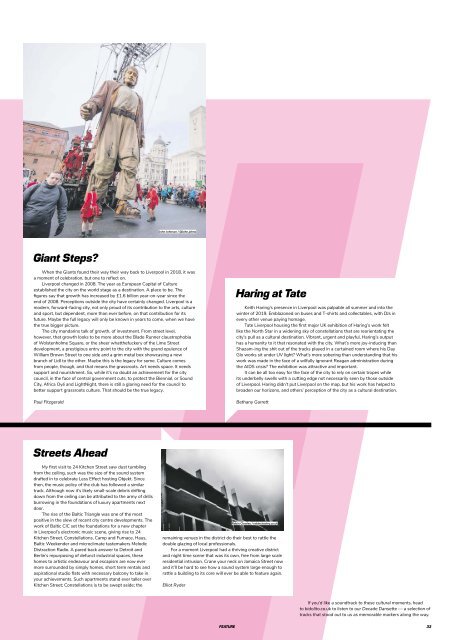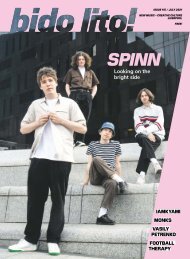Issue 106 / Dec 2019/Jan 2020
December 2019/January 2020 double issue of Bido Lito! magazine. Featuring: BEIJA FLO, ASOK, LO FIVE, SIMON HUGHES, CONVENIENCE GALLERY, BEAK>, STUDIO ELECTROPHONIQUE, ALEX TELEKO, SHE DREW THE GUN, IMTIAZ DHARKER and much more.
December 2019/January 2020 double issue of Bido Lito! magazine. Featuring: BEIJA FLO, ASOK, LO FIVE, SIMON HUGHES, CONVENIENCE GALLERY, BEAK>, STUDIO ELECTROPHONIQUE, ALEX TELEKO, SHE DREW THE GUN, IMTIAZ DHARKER and much more.
Create successful ePaper yourself
Turn your PDF publications into a flip-book with our unique Google optimized e-Paper software.
John Johnson / @John.johno<br />
Giant Steps?<br />
When the Giants found their way their way back to Liverpool in 2018, it was<br />
a moment of celebration, but one to reflect on.<br />
Liverpool changed in 2008. The year as European Capital of Culture<br />
established the city on the world stage as a destination. A place to be. The<br />
figures say that growth has increased by £1.6 billion year-on-year since the<br />
end of 2008. Perceptions outside the city have certainly changed. Liverpool is a<br />
modern, forward-facing city, not only proud of its contribution to the arts, culture<br />
and sport, but dependent, more than ever before, on that contribution for its<br />
future. Maybe the full legacy will only be known in years to come, when we have<br />
the true bigger picture.<br />
The city mandarins talk of growth, of investment. From street level,<br />
however, that growth looks to be more about the Blade Runner claustrophobia<br />
of Wolstenholme Square, or the sheer whatthefuckery of the Lime Street<br />
development, a prestigious entry point to the city with the grand opulence of<br />
William Brown Street to one side and a grim metal box showcasing a new<br />
branch of Lidl to the other. Maybe this is the legacy for some. Culture comes<br />
from people, though, and that means the grassroots. Art needs space. It needs<br />
support and nourishment. So, while it’s no doubt an achievement for the city<br />
council, in the face of central government cuts, to protect the Biennial, or Sound<br />
City, Africa Oyé and LightNight, there is still a glaring need for the council to<br />
better support grassroots culture. That should be the true legacy.<br />
Paul Fitzgerald<br />
Haring at Tate<br />
Keith Haring’s presence in Liverpool was palpable all summer and into the<br />
winter of <strong>2019</strong>. Emblazoned on buses and T-shirts and collectables, with DJs in<br />
every other venue paying homage.<br />
Tate Liverpool housing the first major UK exhibition of Haring’s work felt<br />
like the North Star in a widening sky of constellations that are reorientating the<br />
city’s pull as a cultural destination. Vibrant, urgent and playful, Haring’s output<br />
has a humanity to it that resonated with the city. What’s more joy-inducing than<br />
Shazam-ing the shit out of the tracks played in a curtained room where his Day<br />
Glo works sit under UV light? What’s more sobering than understanding that his<br />
work was made in the face of a wilfully ignorant Reagan administration during<br />
the AIDS crisis? The exhibition was attractive and important.<br />
It can be all too easy for the face of the city to rely on certain tropes while<br />
its underbelly swells with a cutting edge not necessarily seen by those outside<br />
of Liverpool. Haring didn’t put Liverpool on the map, but his work has helped to<br />
broaden our horizons, and others’ perception of the city as a cultural destination.<br />
Bethany Garrett<br />
Streets Ahead<br />
My first visit to 24 Kitchen Street saw dust tumbling<br />
from the ceiling, such was the size of the sound system<br />
drafted in to celebrate Less Effect hosting Objekt. Since<br />
then, the music policy of the club has followed a similar<br />
track. Although now it’s likely small-scale debris drifting<br />
down from the ceiling can be attributed to the army of drills<br />
burrowing in the foundations of luxury apartments next<br />
door.<br />
The rise of the Baltic Triangle was one of the most<br />
positive in the slew of recent city centre developments. The<br />
work of Baltic CIC set the foundations for a new chapter<br />
in Liverpool’s electronic music scene, giving rise to 24<br />
Kitchen Street, Constellations, Camp and Furnace, Haus,<br />
Baltic Weekender and microclimate tastemakers Melodic<br />
Distraction Radio. A pared back answer to Detroit and<br />
Berlin’s repurposing of defunct industrial spaces, these<br />
homes to artistic endeavour and escapism are now ever<br />
more surrounded by simply homes, short term rentals and<br />
aspirational studio flats with necessary balcony to take in<br />
your achievements. Such apartments stand ever taller over<br />
Kitchen Street; Constellations is to be swept aside; the<br />
remaining venues in the district do their best to rattle the<br />
double glazing of local professionals.<br />
For a moment Liverpool had a thriving creative district<br />
and night time scene that was its own, free from large scale<br />
residential intrusion. Crane your neck on Jamaica Street now<br />
and it’ll be hard to see how a sound system large enough to<br />
rattle a building to its core will ever be able to feature again.<br />
Elliot Ryder<br />
Robin Clewley / robinclewley.co.uk<br />
If you’d like a soundtrack to these cultural moments, head<br />
to bidolito.co.uk to listen to our <strong>Dec</strong>ade Dansette — a selection of<br />
tracks that stood out to us as memorable markers along the way.<br />
FEATURE<br />
33

















